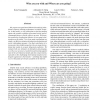Free Online Productivity Tools
i2Speak
i2Symbol
i2OCR
iTex2Img
iWeb2Print
iWeb2Shot
i2Type
iPdf2Split
iPdf2Merge
i2Bopomofo
i2Arabic
i2Style
i2Image
i2PDF
iLatex2Rtf
Sci2ools
112
click to vote
CVPR
2011
IEEE
2011
IEEE
Who are you with and where are you Going?
We propose an agent-based behavioral model of pedestrians to improve tracking performance in realistic scenarios. In this model, we view pedestrians as decision-making agents who consider a plethora of personal, social, and environmental factors to decide where to go next. We formulate prediction of pedestrian behavior as an energy minimization on this model. Two of our main contributions are simple, yet effective estimates of pedestrian destination and social relationships (groups). Our final contribution is to incorporate these hidden properties into an energy formulation that results in accurate behavioral prediction. We evaluate both our estimates of destination and grouping, as well as our accuracy at prediction and tracking against state of the art behavioral model and show improvements, especially in the challenging observational situation of infrequent appearance observations – something that might occur in thousands of webcams available on the Internet.
Accurate Behavioral Prediction | Agent-based Behavioral Model | Behavioral Model | Computer Vision | CVPR 2011 |
Related Content
| Added | 20 Aug 2011 |
| Updated | 20 Aug 2011 |
| Type | Journal |
| Year | 2011 |
| Where | CVPR |
| Authors | Kota Yamaguchi, Alexander Berg, Luis Ortiz, Tamara Berg |
Comments (0)

